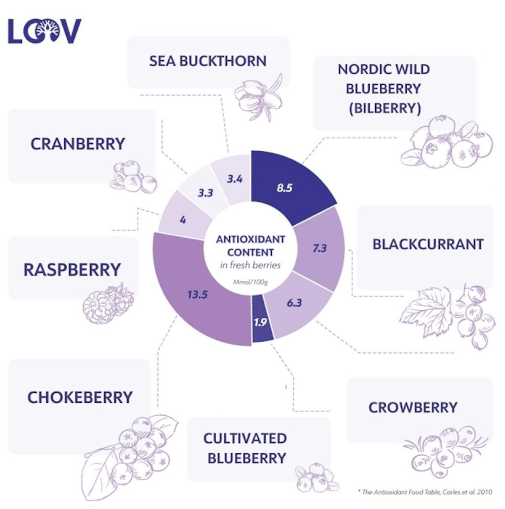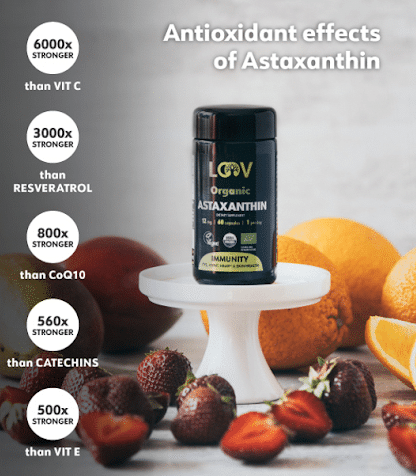Regular, challenging workouts leave you feeling healthy, fit, strong, and on top of the world. However, even if you’re a seasoned gym-goer who knows their limits, it’s easy to overdo it. You push too hard too fast and find yourself too sore to nail your next session.
Table of Contents
Tip #1. Get Enough Good Sleep
Tip #2. Increase Your Protein Intake
Tip #3. Have Active Rest Days
Tip #4. Stock up With Antioxidants
What Is Astaxanthin?
Frequently Asked Questions
What now?
LOOV Food is here to help with the best routines for quick muscle recovery. Follow our tips and go back to the grind in no time.
We’ll discuss these aspects of post-workout recuperation:
- The importance of quality sleep
- Protein for muscle rebuilding
- Soothing rest day activities
- The role of antioxidants for healing
- Astaxanthin for full-body well-being
These practices are lifesavers when you overexert yourself, but they’re also indispensable parts of sustainable fitness. Incorporate them into your schedule to feel your strongest every day of the week.
Let’s explore the science behind the best recovery-boosting post-workout habits and smart ways to put them into practice.
Tip #1. Get Enough Good Sleep
High-quality shut-eye keeps your body and mind healthy, and its significance amplifies after a strenuous workout. The system synthesises protein and releases human growth hormones during the night, promoting recovery and muscle development.
On the other hand, sleep deprivation and disturbances impair your reaction to inflammation. Inadequate rest can even harm muscle strength and size in the long run.
How much sleep do you need after a training session?
An average adult needs to snooze for 7–9 hours each night, and the figure is on the higher end for fitness enthusiasts. For context, some professional athletes report nodding off for 10+ hours each night!
While that’s impossible for most (and unnecessary for an average exerciser), you can only benefit from extending your slumber after a workout. If possible, get as close as possible to nine hours on your exercise days.
💡 Expert Tip:
Have to get up too early for nine hours of sleep? Power naps are the way to go. Let your metabolism return to the state of rest (about two hours after training) and get a 20-minute nap. Stick to quick ZZZs to avoid nighttime troubles.
Tip #2. Increase Your Protein Intake
Protein is an essential nutrient for couch potatoes, runners, walkers, gardeners—you name it. Its importance doubles for avid exercisers, helping them build mass, tone up, and get back to the gym faster.
Protein consists of amino acids, the building blocks of muscle tissue. These super-chemicals reverse the stress damage of heavy lifting, form new tissue and get you stronger for the next push/pull session, leg day or half-marathon.
How much protein do you need? Here are the daily suggestions for people engaging in various exercise types.
| Exercise Type | Protein Amount |
| Endurance training | 0.5–0.7 grams per pound of body weight |
| Strength training | 0.6–0.8 grams per pound of body weight |
| General exercise | 0.6 grams per pound of body weight |
Apart from these general rules, it’s ideal to have a meal with 20–30 grams of protein 30–60 minutes after working out. That way, you’re supplying your muscles with fuel for recovery and growth.
Don’t forget about protein by bedtime if you sweated in the morning, either. Having a snack before dozing off enhances protein synthesis during sleep, letting you wake up limber and stronger than ever.
💡 Expert Tip:
Have to commute right after the gym? Have a protein-rich snack and save the muscle-fuel feast for later. Protein shakes and bars aren’t ideal meal replacements, but your body prefers them to starvation.
Tip #3. Have Active Rest Days
Rest days are as important as your workouts for overall health and fitness. After weightlifting or high-intensity interval training, letting your muscles completely rest helps them grow larger, harder, and stronger.
As a rule of thumb, take time to rest following a hard workout. If that’s not possible with your schedule, train different muscle group(s) the next day, putting as little strain on the sore spots as possible.
Even if you decide to take a day off, don’t just veg out on the couch. Muscle soreness requires rest, but full-day inactivity is unlikely to get you feeling any better.
Instead of sitting the soreness away, engage in active rest to stimulate and stretch out your muscles. Keep moving on your off days to diminish soreness and develop mobility and flexibility while regaining strength.
What kinds of workouts fit the bill?
Active rest comes in all shapes and sizes, depending on your fitness levels and preferences. If quick recovery is the goal, these activities work like a charm.
| Activity Type | How It Helps |
| Yoga | Boosts muscle and joint health, relieves tension |
| Walking, jogging, cycling | Increases blood flow to muscles |
| Swimming | Improves blood flow, promotes mobility |
| Foam rolling | Releases muscle tension and diminishes soreness |
💡 Expert Tip:
Too sore for cardiovascular activities? Try active stretching. Hold each position for a maximum of 30 seconds to get the blood flowing and loosen up.
Tip #4. Stock up With Antioxidants
Free radicals cause oxidative stress and inflammation, but they’re an inevitable part of challenging your strength and endurance. Antioxidants are antidotes for these nasty side effects, and a supply of these feel-good compounds does wonders for recovery.
These healthy ingredients don’t stop at healing your muscles, either. Their benefits include:
- Enhanced immunity
- Disease prevention
- Better complexion
- Improved eye health
- Sharper brain function
You get all these perks by filling up your plate with fruits and veggies—amazing!
A fit lifestyle is already brimming with antioxidant-rich foods, letting you stay healthy and happy without mulling over your micronutrients. What if you wanted to take things one step further, though?
A strategic antioxidant-rich meal right after a workout can assist your recovery.
Make sure your after-gym snack and dinner on the same day provide a good antioxidant supply. Have a big plate of leafy greens, berries or another plant-based antioxidant source.

Alternatively, choose a high-quality antioxidant supplement for convenience purposes.
Our organic astaxanthin is a shining example of an all-natural supplement that serves your entire body. Use it to take your lifestyle, diet and exercise game to the next level.
As we mentioned, taking antioxidants isn’t something exclusively for individuals seeking to speed up muscle recovery. They promote your overall well-being, especially when you get them from the best possible sources.
Trust us—it doesn’t get much better than astaxanthin.
Astaxanthin is a terpene (aromatic compound) found in some microalgae species. It’s one of the world’s most potent antioxidants, jam-packed with health-boosting properties.
The astaxanthin products from LOOV Food are free of added sugar, preservatives, and synthetic ingredients. Gluten-free and non-GMO, they’re suitable for all diets and lifestyles.
One capsule a day is enough to boost your overall functioning, up to and past the point of muscle recovery.
“Works great!
Taking astaxanthin has helped my joint pain in my knees so much. … I’ve noticed an increase in my overall energy levels as well.”
— SW, United States

Frequently Asked Questions
Is it okay to exercise with sore muscles?
Soreness is the body’s sign that it needs rest. Ignoring the signals leads to overexertion, burnout and potential injury.
However, it’s not all black and white.
Some muscle tension is a natural part of your active lifestyle. You don’t have to wait to feel completely healed for your next training session, as long as you listen to your body and respect the amount of soreness you can take.
What should I eat and drink for muscle recovery?
Stick to a plant-based, protein-rich diet to stay fit and healthy. Respecting this principle in your overall nutrition is much more relevant than nailing your post-workout meal.
If you want to get super-specific, though, focus on these three aspects:
- Hydration—to flush out toxins and relieve muscle tension
- Protein—to help muscle tissue rebuild and grow
- Antioxidants—to minimise free radical action and soreness
What should I look for when buying antioxidant supplements?
In essence, it’s always best to get your antioxidants from real foods. Supplementation makes things much more convenient, but only with the right products in your corner.
Look for supplements that are:
- Derived from superfoods
- Vegan and organic
- All-natural and free of synthetic ingredients
- Produced with strict quality control
The supplements from LOOV Food meet these standards, making them a leading product for health-conscious individuals.








